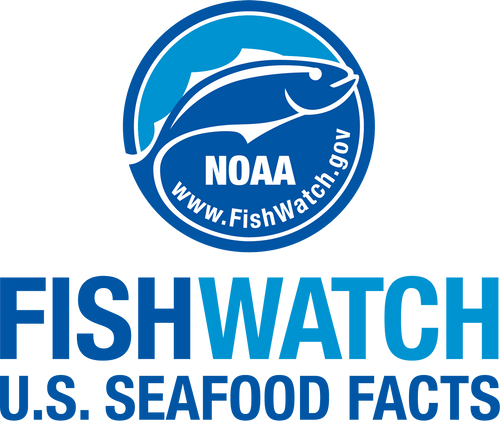 School of bluefin tuna. Credit: NOAA Fisheries
School of bluefin tuna. Credit: NOAA Fisheries
School of bluefin tuna. Credit: NOAA Fisheries
About the Species
 School of bluefin tuna. Credit: NOAA Fisheries
School of bluefin tuna. Credit: NOAA Fisheries
School of bluefin tuna. Credit: NOAA Fisheries
U.S. wild-caught western Atlantic bluefin tuna is a smart seafood choice because it is sustainably managed under a rebuilding plan that allows limited harvest by U.S. fishermen.

Population
The population level is unknown, but management measures are in place.

Fishing Rate
Not subject to overfishing.

Habitat Impact
Fishing gear used to catch bluefin tuna rarely contacts the ocean floor and has minimal impact on habitat.

Bycatch
Fishing gear used by U.S. fishermen to target schools of bluefin tuna is fairly selective, and allows for the live release of any unintentionally caught species.
Population Status
- According to the 2021 stock assessment western Atlantic bluefin tuna stock is not subject to overfishing, but the overfished status is unknown. Summary stock assessment information can be found on Stock SMART.
- For 2023, the stock is being managed under ICCAT Recommendation 21-10 that is responsive to scientific advice.
- Regulations do not allow targeted fishing of bluefin tuna in the Gulf of Mexico, an important spawning area for the species.
Appearance
- Atlantic bluefin tuna have large, torpedo-shaped bodies that are nearly circular in cross-section.
- They are the largest of the tuna species and can reach up to 13 feet and 2,000 pounds.
- They have dark blue-black on the back and white on the lower sides and belly.
- Atlantic bluefin tuna have colorless lines alternating with rows of colorless spots on their lower sides.
- The second fin on their back (dorsal fin) is reddish brown, and they have short pectoral fins.
- These characteristics separate this species from other members of the tuna genus, Thunnus.
Biology
- Bluefin tuna grow more slowly than other tuna.
- They have a long lifespan, up to 20 years or more and generally don’t spawn until they are about 8 years old.
- They spawn from mid-April to June, mainly in the Gulf of Mexico.
- Females can produce up to 10 million eggs a year.
- The eggs are fertilized in the water column and hatch in about 2 days.
- Bluefin tuna are top predators.
- Juveniles eat fish, squid, and crustaceans, and adults feed mainly on baitfish such as herring, bluefish, and mackerel.
- Sharks, marine mammals (including killer whales and pilot whales), and large fish feed on bluefin tuna. Bluefish and seabirds also prey upon juvenile bluefin tuna.
Where They Live
Range
- In the western Atlantic, bluefin tuna are found from Newfoundland to the Gulf of Mexico.
Habitat
- Atlantic bluefin tuna live near the surface in temperate waters but frequently dive to depths of 500 to 1,000 meters.
- They are a highly migratory species. They can migrate thousands of miles across an entire ocean.
- Tagging studies have indicated that bluefin tuna move across the east/west boundary in the Atlantic.
- They tend to spawn in the same areas in the Gulf of Mexico.
Fishery Management
- Effective conservation and management of highly migratory species like bluefin tuna require international cooperation as well as strong domestic management.
- NOAA Fisheries, through the Atlantic Highly Migratory Species Management Division, manages the Atlantic bluefin tuna fishery in the United States, and sets regulations for the U.S. fishery based on conservation and management recommendations from the International Commission for the Conservation of Atlantic Tunas (ICCAT), consistent with applicable U.S. laws.
- Managed under the 2006 Consolidated Atlantic Highly Migratory Species Fishery Management Plan and amendments:
- Commercial and recreational fishermen must have a permit to harvest bluefin tuna.
- Annual quota and subquotas
- Gear restrictions
- Time/area closures
- Minimum size limits
- Federal management for Atlantic tunas applies to state waters as well, except in Connecticut, and Mississippi. NOAA Fisheries periodically reviews these states’ regulations to make sure they’re consistent with federal regulations.
- Regulations do not allow targeted fishing of bluefin tuna in the Gulf of Mexico, an important spawning area for the species.
- NOAA Fisheries published several recent regulations that are expected to reduce and improve accounting for bluefin tuna dead discards, including gear restricted areas and individual transferable quotas in the pelagic longline fishery, modified quota category allocations, and enhanced monitoring and reporting.
- In 2000, the United States established the Dolphin-Safe Tuna Tracking and Verification Program to monitor the domestic production and importation of all frozen and processed tuna products nationwide, and to authenticate any associated dolphin-safe claim.
Harvest
- ICCAT implemented harvest quotas for the western Atlantic bluefin tuna stock in 1982. Since then, catch has been relatively stable.
- U.S. catch comprises about half of the total western Atlantic bluefin tuna catch and less than 10 percent of Atlantic-wide bluefin tuna catch (including the Mediterranean Sea).
- Gear types, habitat impacts, and bycatch:
- U.S. fishermen harvest bluefin tuna with handgear (rod-and-reel, handline, and harpoon) and purse seines.
- Although fishermen are not allowed to use pelagic longline gear in the United States to target bluefin tuna directly, regulations allow them to retain a limited number of bluefin tuna caught incidentally while fishing for other species such as swordfish and yellowfin tuna.
- Fishermen generally target schools of bluefin tuna, and their fishing gear is fairly selective and allows for the live release of any unintentionally caught species.
- Fishing gear used to catch bluefin tuna rarely contacts the ocean floor and therefore has minimal impact on habitat.
- NOAA Fisheries requires U.S. commercial fishermen who fish for yellowfin tuna, swordfish, and other species with pelagic longlines in the Gulf of Mexico to use weak hooks, a type of hook designed to reduce the incidental catch and bycatch of Atlantic bluefin tuna.
- Fishing for bluefin tuna in two known hotspots—Cape Hatteras, North Carolina and the Gulf of Mexico—is strictly regulated.
- Commercial harvest:
- In 2022, commercial landings of Atlantic bluefin tuna totaled 2.3 million pounds and were valued at $12.1 million, according to the NOAA Fisheries commercial fishing landings database.
- Ex-vessel prices depend on a number of factors, including the quality of the fish (e.g., freshness, fat content, method of storage), the weight of the fish, the supply of fish, and consumer demand.
- Exports vary from year to year. The majority of exported U.S. Atlantic Bluefin tuna catch is sent to sushi markets in Japan.
- Exports of Atlantic bluefin tuna generally depend on the amount of commercial landings and Japanese yen/U.S. dollar exchange rates.
- Recreational U.S. fishery:
- Recreationally-caught bluefin tuna may not be sold.
- Bluefin tuna must be larger than 27 inches to be retained.
- Depending on the recreational fishery (e.g., private vessels and charter/headboat vessels), limits on the amount and size of fish that fishermen can keep per fishing trip vary. For the latest information on current retention limits, visit the NOAA Fisheries HMS Permit Shop.
- All released bluefin tuna must be released without removing the fish from the water and in a manner that will maximize its survival.
- Recreational fishing for highly migratory species such as bluefin tuna provides significant economic benefits to coastal communities through individual angler expenditures, recreational charters, tournaments, and the shoreside businesses that support those activities.
- In 2022, recreational anglers landed 4.2 million pounds of bluefin tuna, according to the NOAA Fisheries recreational fishing landings database.
Scientific Classification
- In the western Atlantic, bluefin tuna are found from Newfoundland to the Gulf of Mexico.
- Atlantic bluefin tuna live near the surface in temperate waters but frequently dive to depths of 500 to 1,000 meters.
- They are a highly migratory species. They can migrate thousands of miles across an entire ocean.
- Tagging studies have indicated that bluefin tuna move across the east/west boundary in the Atlantic.
- They tend to spawn in the same areas in the Gulf of Mexico.
Fishery Management
- Effective conservation and management of highly migratory species like bluefin tuna require international cooperation as well as strong domestic management.
- NOAA Fisheries, through the Atlantic Highly Migratory Species Management Division, manages the Atlantic bluefin tuna fishery in the United States, and sets regulations for the U.S. fishery based on conservation and management recommendations from the International Commission for the Conservation of Atlantic Tunas (ICCAT), consistent with applicable U.S. laws.
- Managed under the 2006 Consolidated Atlantic Highly Migratory Species Fishery Management Plan and amendments:
- Commercial and recreational fishermen must have a permit to harvest bluefin tuna.
- Annual quota and subquotas
- Gear restrictions
- Time/area closures
- Minimum size limits
- Federal management for Atlantic tunas applies to state waters as well, except in Connecticut, and Mississippi. NOAA Fisheries periodically reviews these states’ regulations to make sure they’re consistent with federal regulations.
- Regulations do not allow targeted fishing of bluefin tuna in the Gulf of Mexico, an important spawning area for the species.
- NOAA Fisheries published several recent regulations that are expected to reduce and improve accounting for bluefin tuna dead discards, including gear restricted areas and individual transferable quotas in the pelagic longline fishery, modified quota category allocations, and enhanced monitoring and reporting.
- In 2000, the United States established the Dolphin-Safe Tuna Tracking and Verification Program to monitor the domestic production and importation of all frozen and processed tuna products nationwide, and to authenticate any associated dolphin-safe claim.
Harvest
- ICCAT implemented harvest quotas for the western Atlantic bluefin tuna stock in 1982. Since then, catch has been relatively stable.
- U.S. catch comprises about half of the total western Atlantic bluefin tuna catch and less than 10 percent of Atlantic-wide bluefin tuna catch (including the Mediterranean Sea).
- Gear types, habitat impacts, and bycatch:
- U.S. fishermen harvest bluefin tuna with handgear (rod-and-reel, handline, and harpoon) and purse seines.
- Although fishermen are not allowed to use pelagic longline gear in the United States to target bluefin tuna directly, regulations allow them to retain a limited number of bluefin tuna caught incidentally while fishing for other species such as swordfish and yellowfin tuna.
- Fishermen generally target schools of bluefin tuna, and their fishing gear is fairly selective and allows for the live release of any unintentionally caught species.
- Fishing gear used to catch bluefin tuna rarely contacts the ocean floor and therefore has minimal impact on habitat.
- NOAA Fisheries requires U.S. commercial fishermen who fish for yellowfin tuna, swordfish, and other species with pelagic longlines in the Gulf of Mexico to use weak hooks, a type of hook designed to reduce the incidental catch and bycatch of Atlantic bluefin tuna.
- Fishing for bluefin tuna in two known hotspots—Cape Hatteras, North Carolina and the Gulf of Mexico—is strictly regulated.
- Commercial harvest:
- In 2022, commercial landings of Atlantic bluefin tuna totaled 2.3 million pounds and were valued at $12.1 million, according to the NOAA Fisheries commercial fishing landings database.
- Ex-vessel prices depend on a number of factors, including the quality of the fish (e.g., freshness, fat content, method of storage), the weight of the fish, the supply of fish, and consumer demand.
- Exports vary from year to year. The majority of exported U.S. Atlantic Bluefin tuna catch is sent to sushi markets in Japan.
- Exports of Atlantic bluefin tuna generally depend on the amount of commercial landings and Japanese yen/U.S. dollar exchange rates.
- Recreational U.S. fishery:
- Recreationally-caught bluefin tuna may not be sold.
- Bluefin tuna must be larger than 27 inches to be retained.
- Depending on the recreational fishery (e.g., private vessels and charter/headboat vessels), limits on the amount and size of fish that fishermen can keep per fishing trip vary. For the latest information on current retention limits, visit the NOAA Fisheries HMS Permit Shop.
- All released bluefin tuna must be released without removing the fish from the water and in a manner that will maximize its survival.
- Recreational fishing for highly migratory species such as bluefin tuna provides significant economic benefits to coastal communities through individual angler expenditures, recreational charters, tournaments, and the shoreside businesses that support those activities.
- In 2022, recreational anglers landed 4.2 million pounds of bluefin tuna, according to the NOAA Fisheries recreational fishing landings database.
Scientific Classification
| Kingdom | Animalia | Phylum | Chordata | Class | Actinopterygii | Order | Scombriformes | Family | Scombridae | Genus | Thunnus | Species | thynnus |
|---|
Last updated by NOAA Fisheries on 09/09/2024
Featured News
 School of yellowfin tuna. Credit: Jeff Muir
School of yellowfin tuna. Credit: Jeff Muir

Seafood Facts

Is Western Atlantic Bluefin Tuna Sustainable?
U.S. wild-caught western Atlantic bluefin tuna is a smart seafood choice because it is sustainably managed under a conservation and management plan that allows limited harvest by U.S. fishermen.
Availability
Year-round.
Source
U.S. wild-caught from Maine to Louisiana.
Taste
Bluefin has a distinctive flavor. With its high fat content, it is especially prized for sushi and sashimi. Cooking is generally not advised as it produces a strong fish taste and odor.
Texture
Bluefin tuna flesh is the darkest and fattiest of any tuna. A higher fat content in bluefin tuna is equated with a higher-quality product. The flesh has the firmness and appearance of beef steaks.
Color
Deep red when uncooked. When cooked, the meat is an off-white or ivory color.
Health Benefits
Bluefin tuna is a very good source of protein, thiamin, selenium, vitamin B6, and omega-3 fatty acids.
Nutrition Facts
Servings: 1; Serving Weight: 100 g (raw); Calories: 144; Protein: 23.33 g; Total Fat: 4.9 g; Total Saturated Fatty Acids: 1.257 g; Carbohydrate: 0 g; Total Sugars: 0 g; Total Dietary Fiber: 0 g; Cholesterol: 38 mg; Selenium: 36.5 mcg; Sodium: 39 mgMore Information
Last updated by NOAA Fisheries on 09/09/2024
Seafood News
 NOAA Fisheries, in collaboration with Blue Ocean Mariculture, is conducting a multi-year pilot study to evaluate observational methods and tools for studying Hawaiian monk seal behavior. Courtesy of Blue Ocean Mariculture
NOAA Fisheries, in collaboration with Blue Ocean Mariculture, is conducting a multi-year pilot study to evaluate observational methods and tools for studying Hawaiian monk seal behavior. Courtesy of Blue Ocean Mariculture
 Tonya Wick aboard a fishing vessel at sea in 1998. Photo courtesy of Tonya Wick
Tonya Wick aboard a fishing vessel at sea in 1998. Photo courtesy of Tonya Wick
 Fish on display at the market. Credit: Shutterstock
Fish on display at the market. Credit: Shutterstock
 Fishermen offloading. Credit: Shutterstock
Fishermen offloading. Credit: Shutterstock
Documents
Three-Year Review of the Individual Bluefin Quota Program
An evaluation of the effectiveness of the Individual Bluefin Quota Program.
Endangered Species Act Status Review of Atlantic Bluefin Tuna (Thunnus thynnus)
The 2011 status review report conducted on a petition from the Center for Biological Diversity (CBD…
Outreach & Education
A Guide to Tunas of the Western Atlantic Ocean
Waterproof booklet to help commercial, for-hire, and recreational fishermen and fish dealers/buyers…
Caribbean Saltwater Recreational Fisheries Snapshot
Puerto Rico and the U.S. Virgin Islands saltwater recreational fisheries fact sheet highlighting…
Last updated by NOAA Fisheries on 09/09/2024





